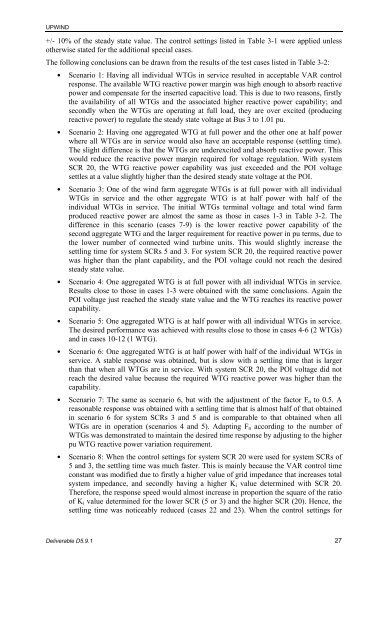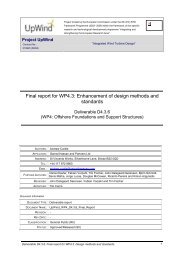Impact of Drivetrain on Wind Farm VAR Control - Upwind
Impact of Drivetrain on Wind Farm VAR Control - Upwind
Impact of Drivetrain on Wind Farm VAR Control - Upwind
Create successful ePaper yourself
Turn your PDF publications into a flip-book with our unique Google optimized e-Paper software.
UPWIND<br />
+/- 10% <str<strong>on</strong>g>of</str<strong>on</strong>g> the steady state value. The c<strong>on</strong>trol settings listed in Table 3-1 were applied unless<br />
otherwise stated for the additi<strong>on</strong>al special cases.<br />
The following c<strong>on</strong>clusi<strong>on</strong>s can be drawn from the results <str<strong>on</strong>g>of</str<strong>on</strong>g> the test cases listed in Table 3-2:<br />
• Scenario 1: Having all individual WTGs in service resulted in acceptable <strong>VAR</strong> c<strong>on</strong>trol<br />
resp<strong>on</strong>se. The available WTG reactive power margin was high enough to absorb reactive<br />
power and compensate for the inserted capacitive load. This is due to two reas<strong>on</strong>s, firstly<br />
the availability <str<strong>on</strong>g>of</str<strong>on</strong>g> all WTGs and the associated higher reactive power capability; and<br />
sec<strong>on</strong>dly when the WTGs are operating at full load, they are over excited (producing<br />
reactive power) to regulate the steady state voltage at Bus 3 to 1.01 pu.<br />
• Scenario 2: Having <strong>on</strong>e aggregated WTG at full power and the other <strong>on</strong>e at half power<br />
where all WTGs are in service would also have an acceptable resp<strong>on</strong>se (settling time).<br />
The slight difference is that the WTGs are underexcited and absorb reactive power. This<br />
would reduce the reactive power margin required for voltage regulati<strong>on</strong>. With system<br />
SCR 20, the WTG reactive power capability was just exceeded and the POI voltage<br />
settles at a value slightly higher than the desired steady state voltage at the POI.<br />
• Scenario 3: One <str<strong>on</strong>g>of</str<strong>on</strong>g> the wind farm aggregate WTGs is at full power with all individual<br />
WTGs in service and the other aggregate WTG is at half power with half <str<strong>on</strong>g>of</str<strong>on</strong>g> the<br />
individual WTGs in service. The initial WTGs terminal voltage and total wind farm<br />
produced reactive power are almost the same as those in cases 1-3 in Table 3-2. The<br />
difference in this scenario (cases 7-9) is the lower reactive power capability <str<strong>on</strong>g>of</str<strong>on</strong>g> the<br />
sec<strong>on</strong>d aggregate WTG and the larger requirement for reactive power in pu terms, due to<br />
the lower number <str<strong>on</strong>g>of</str<strong>on</strong>g> c<strong>on</strong>nected wind turbine units. This would slightly increase the<br />
settling time for system SCRs 5 and 3. For system SCR 20, the required reactive power<br />
was higher than the plant capability, and the POI voltage could not reach the desired<br />
steady state value.<br />
• Scenario 4: One aggregated WTG is at full power with all individual WTGs in service.<br />
Results close to those in cases 1-3 were obtained with the same c<strong>on</strong>clusi<strong>on</strong>s. Again the<br />
POI voltage just reached the steady state value and the WTG reaches its reactive power<br />
capability.<br />
• Scenario 5: One aggregated WTG is at half power with all individual WTGs in service.<br />
The desired performance was achieved with results close to those in cases 4-6 (2 WTGs)<br />
and in cases 10-12 (1 WTG).<br />
• Scenario 6: One aggregated WTG is at half power with half <str<strong>on</strong>g>of</str<strong>on</strong>g> the individual WTGs in<br />
service. A stable resp<strong>on</strong>se was obtained, but is slow with a settling time that is larger<br />
than that when all WTGs are in service. With system SCR 20, the POI voltage did not<br />
reach the desired value because the required WTG reactive power was higher than the<br />
capability.<br />
• Scenario 7: The same as scenario 6, but with the adjustment <str<strong>on</strong>g>of</str<strong>on</strong>g> the factor Fn to 0.5. A<br />
reas<strong>on</strong>able resp<strong>on</strong>se was obtained with a settling time that is almost half <str<strong>on</strong>g>of</str<strong>on</strong>g> that obtained<br />
in scenario 6 for system SCRs 3 and 5 and is comparable to that obtained when all<br />
WTGs are in operati<strong>on</strong> (scenarios 4 and 5). Adapting Fn according to the number <str<strong>on</strong>g>of</str<strong>on</strong>g><br />
WTGs was dem<strong>on</strong>strated to maintain the desired time resp<strong>on</strong>se by adjusting to the higher<br />
pu WTG reactive power variati<strong>on</strong> requirement.<br />
• Scenario 8: When the c<strong>on</strong>trol settings for system SCR 20 were used for system SCRs <str<strong>on</strong>g>of</str<strong>on</strong>g><br />
5 and 3, the settling time was much faster. This is mainly because the <strong>VAR</strong> c<strong>on</strong>trol time<br />
c<strong>on</strong>stant was modified due to firstly a higher value <str<strong>on</strong>g>of</str<strong>on</strong>g> grid impedance that increases total<br />
system impedance, and sec<strong>on</strong>dly having a higher Ki value determined with SCR 20.<br />
Therefore, the resp<strong>on</strong>se speed would almost increase in proporti<strong>on</strong> the square <str<strong>on</strong>g>of</str<strong>on</strong>g> the ratio<br />
<str<strong>on</strong>g>of</str<strong>on</strong>g> Ki value determined for the lower SCR (5 or 3) and the higher SCR (20). Hence, the<br />
settling time was noticeably reduced (cases 22 and 23). When the c<strong>on</strong>trol settings for<br />
Deliverable D5.9.1 27











